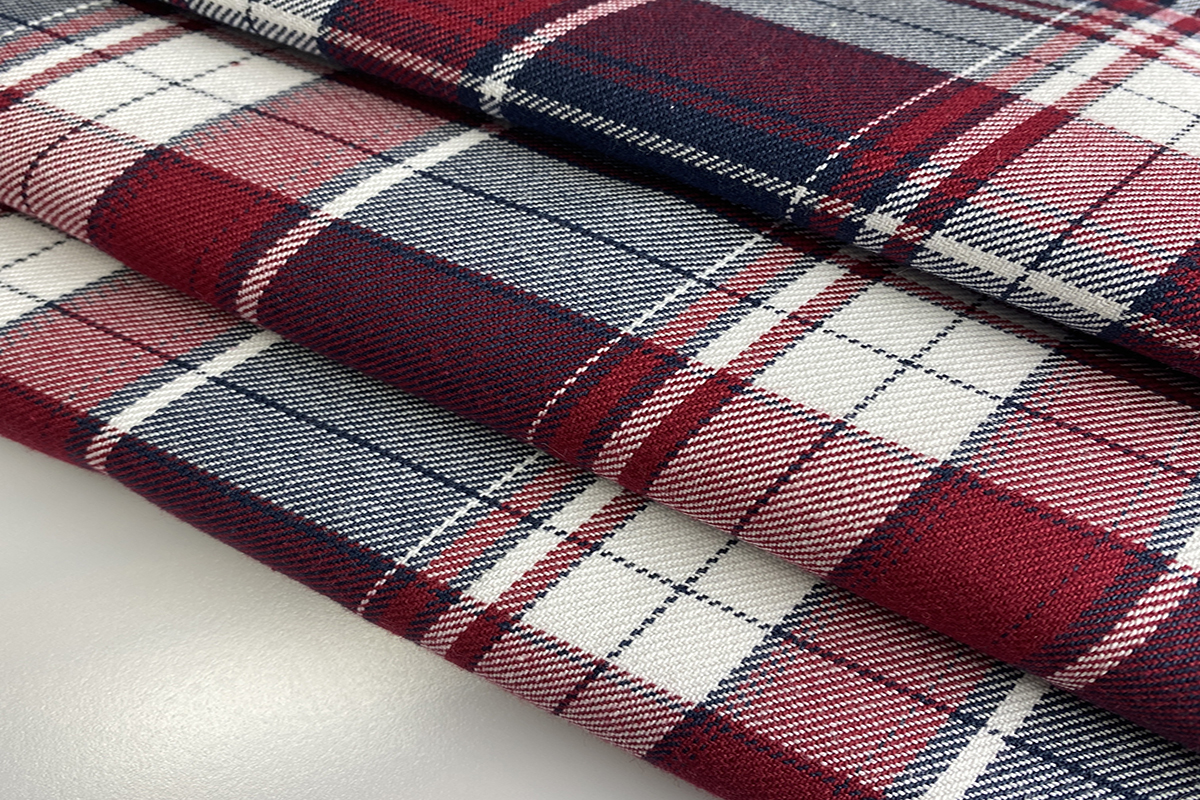 Polyester has become a popular choice for school uniforms fabric. Its durability ensures that garments withstand daily wear and frequent washing. Parents often prefer it because it offers affordability without compromising practicality. Polyester resists wrinkles and stains, making it easy to maintain. However, its synthetic nature raises concerns. Many wonder if it affects comfort or poses health risks for children. Additionally, its environmental impact sparks debates. Despite its advantages, the choice of polyester as a school uniform fabric continues to invite scrutiny.
Polyester has become a popular choice for school uniforms fabric. Its durability ensures that garments withstand daily wear and frequent washing. Parents often prefer it because it offers affordability without compromising practicality. Polyester resists wrinkles and stains, making it easy to maintain. However, its synthetic nature raises concerns. Many wonder if it affects comfort or poses health risks for children. Additionally, its environmental impact sparks debates. Despite its advantages, the choice of polyester as a school uniform fabric continues to invite scrutiny.Key Takeaways
- Polyester is highly durable, making it ideal for school uniforms that withstand daily wear and frequent washing.
- Affordability is a major advantage of polyester, allowing more families to access quality school uniforms without breaking the bank.
- The ease of maintenance with polyester uniforms saves parents time, as they resist stains and wrinkles and dry quickly after washing.
- Comfort can be a concern with polyester, as it may trap heat and moisture, leading to discomfort for students, especially in warmer climates.
- Environmental impact is a significant drawback of polyester, as its production contributes to pollution and microplastic shedding.
- Blended fabrics, combining polyester with natural fibers, can offer a balance of durability and comfort, making them a versatile option for school uniforms.
- Considering sustainable alternatives like recycled polyester or organic cotton can align school uniform choices with eco-conscious values, despite potentially higher costs.
Benefits of Polyester in School Uniforms Fabric
 Durability and Longevity
Durability and LongevityPolyester stands out for its exceptional durability. I have observed how this fabric resists wear and tear, even after months of daily use. Students often engage in activities that test the limits of their clothing. Polyester handles these challenges with ease. It resists stretching, shrinking, and wrinkling, which ensures that school uniforms maintain their shape and appearance over time. Frequent washing does not compromise its quality. This makes polyester a reliable choice for school uniforms fabric, especially for active students who need garments that can keep up with their energy.
Affordability and Accessibility
Affordability plays a significant role in the popularity of polyester. Many families prioritize cost-effective options when purchasing school uniforms. Polyester offers a budget-friendly solution without sacrificing essential qualities like durability and practicality. Its production process allows manufacturers to create high-quality garments at a lower cost. This accessibility ensures that more families can afford school uniforms fabric that meets their needs. I believe this affordability makes polyester an appealing option for schools aiming to provide standardized uniforms for all students.
Ease of Maintenance and Practicality
Polyester simplifies the maintenance of school uniforms. I have noticed how easy it is to care for this fabric. It resists stains and wrinkles, which reduces the time spent on ironing or spot cleaning. Parents appreciate how quickly polyester uniforms dry after washing, making them ready for use in no time. This practicality proves invaluable during busy school weeks. Additionally, polyester retains vibrant colors and a polished appearance, even after repeated washes. These qualities make it a practical and efficient choice for school uniforms fabric.
Drawbacks of Polyester in School Uniforms Fabric
Comfort and Breathability Concerns
I have noticed that polyester often lacks the comfort provided by natural fabrics. Its synthetic nature makes it less breathable, which can cause discomfort for students during long school hours. When temperatures rise, polyester traps heat and moisture against the skin. This can lead to excessive sweating and irritation. I believe this issue becomes more pronounced in regions with hot or humid climates. Students may find it harder to focus on their studies when their uniforms feel sticky or uncomfortable. While polyester offers durability, its inability to provide adequate ventilation remains a significant drawback.
Environmental Impact and Sustainability Issues
Polyester production contributes to environmental challenges. The fabric is derived from petroleum, a non-renewable resource. Manufacturing polyester releases greenhouse gases, which accelerate climate change. I have also learned that washing polyester garments sheds microplastics into water systems. These tiny particles harm aquatic life and eventually enter the food chain. Disposal of polyester uniforms adds to the problem, as the material takes decades to decompose in landfills. Although recycled polyester offers a more sustainable option, it does not fully address these environmental concerns. I think schools and parents should consider these factors when selecting school uniforms fabric.
Potential Health Risks for Children
Polyester may pose health risks for children. I have read that its synthetic fibers can irritate sensitive skin, leading to rashes or itching. Prolonged exposure to polyester may also cause discomfort for children with allergies or skin conditions like eczema. Additionally, the fabric’s inability to wick away moisture effectively creates a breeding ground for bacteria. This can result in unpleasant odors or even skin infections. I believe parents should remain cautious about these potential risks. Choosing a fabric that prioritizes both durability and health is essential for children’s well-being.
Comparing Polyester to Other School Uniforms Fabric Options

Polyester vs. Cotton
I have often compared polyester and cotton when evaluating school uniforms fabric. Cotton, a natural fiber, offers superior breathability and softness. It feels gentle against the skin, making it a comfortable choice for students. However, I have noticed that cotton lacks the durability of polyester. It tends to shrink, wrinkle, and fade after repeated washes. This makes maintenance more challenging for parents. Polyester, on the other hand, resists these issues and retains its shape and color over time. While cotton excels in comfort, polyester outperforms it in practicality and longevity.
Polyester vs. Blended Fabrics
Blended fabrics combine the strengths of polyester with other materials like cotton or rayon. I find this combination creates a balance between durability and comfort. For instance, polyester-cotton blends offer the breathability of cotton and the resilience of polyester. These blends also reduce the drawbacks of pure polyester, such as its lack of ventilation. I have observed that blended fabrics maintain their shape well and feel softer than pure polyester. However, they may cost slightly more. Despite this, I believe blended fabrics provide a versatile option for school uniforms fabric, meeting both comfort and durability needs.
Polyester vs. Sustainable Alternatives
Sustainable alternatives, such as recycled polyester or organic cotton, have gained attention in recent years. I appreciate how recycled polyester addresses some environmental concerns associated with traditional polyester. It reduces waste by repurposing plastic bottles into fabric. Organic cotton, on the other hand, eliminates harmful chemicals during production. These options promote sustainability while offering quality. However, I have noticed that sustainable fabrics often come with higher price tags. Schools and parents must weigh the environmental benefits against the cost. While polyester remains affordable, sustainable alternatives align better with eco-conscious values.
Polyester offers a practical solution for school uniforms fabric. Its durability and affordability make it a reliable choice for parents and schools. However, I believe its drawbacks, such as limited comfort and environmental concerns, cannot be ignored. Blended fabrics or sustainable alternatives provide better options for balancing durability, comfort, and eco-friendliness. Schools and parents should carefully evaluate these factors before making decisions. Prioritizing the well-being of students and the environment ensures a more thoughtful approach to selecting school uniforms.
FAQ
What makes polyester a popular choice for school uniforms?
Polyester stands out due to its durability, affordability, and ease of maintenance. I have seen how it resists wear and tear, even with daily use. It also retains its shape and color after frequent washing. These qualities make it a practical option for active students and busy parents.
Is polyester comfortable for students to wear all day?
Polyester offers durability but lacks the comfort of natural fabrics like cotton. I have noticed that it traps heat and moisture, especially in warm climates. This can make students feel uncomfortable during long school hours. Blended fabrics or breathable alternatives may provide better comfort.
Does polyester cause skin irritation in children?
Polyester can irritate sensitive skin. I have read that its synthetic fibers may lead to rashes or itching, particularly for children with allergies or skin conditions. Parents should monitor their children’s reactions to polyester uniforms and consider alternatives if irritation occurs.
How does polyester impact the environment?
Polyester production relies on petroleum, a non-renewable resource. I have learned that its manufacturing process emits greenhouse gases. Washing polyester also releases microplastics into water systems, harming aquatic life. While recycled polyester offers a more sustainable option, it does not eliminate these environmental concerns.
Are there sustainable alternatives to polyester for school uniforms?
Yes, sustainable options like recycled polyester and organic cotton are available. I appreciate how recycled polyester repurposes plastic waste, reducing environmental impact. Organic cotton avoids harmful chemicals during production. These alternatives align with eco-conscious values but may cost more than traditional polyester.
How do polyester-cotton blends compare to pure polyester?
Polyester-cotton blends combine the strengths of both fabrics. I have observed that these blends offer the breathability of cotton and the durability of polyester. They feel softer and more comfortable than pure polyester while maintaining resilience. However, they may come at a slightly higher price.
Can polyester uniforms withstand frequent washing?
Polyester handles frequent washing exceptionally well. I have noticed that it resists shrinking, stretching, and fading. Its wrinkle-resistant nature ensures that uniforms maintain a polished appearance over time. This makes it a reliable choice for parents seeking low-maintenance school uniforms.
Is recycled polyester a good option for school uniforms?
Recycled polyester provides a more sustainable alternative to traditional polyester. I value how it reduces plastic waste by repurposing materials like plastic bottles. While it retains the durability of regular polyester, it still shares some drawbacks, such as limited breathability and microplastic shedding.
Why do schools prefer polyester for uniforms?
Schools often choose polyester for its affordability and practicality. I have seen how it allows schools to provide standardized uniforms at a lower cost. Its durability ensures that uniforms last longer, reducing the need for frequent replacements. These factors make polyester a cost-effective solution for schools.
Should parents prioritize comfort or durability when choosing school uniforms?
I believe parents should strike a balance between comfort and durability. While polyester offers longevity, it may lack the comfort of natural fabrics. Blended fabrics or sustainable options can provide a middle ground, ensuring that students feel comfortable while wearing durable uniforms.
Post time: Dec-30-2024
